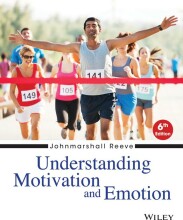Summary: Understanding Motivation And Emotion, 6Th Edition | 9781118804704 | Johnmarshall Reeve
- This + 400k other summaries
- A unique study and practice tool
- Never study anything twice again
- Get the grades you hope for
- 100% sure, 100% understanding
Read the summary and the most important questions on Understanding Motivation and Emotion, 6th Edition | 9781118804704 | Johnmarshall Reeve
-
1 Introduction
This is a preview. There are 25 more flashcards available for chapter 1
Show more cards here -
Five ways that you can know motivation when you see it
Behavior, engagement, psychophysiology, brain activations and self-report -
Behavior effort that indicate motivation
Persistence ,latency , choice, probability of response,
facial expressions and bodily gestures -
Engagement is a multidimensional construct that consists of the four distinct
- Behavior
- Emotion
Cognition - Agency
- Behavior
-
2 Motivation and emotion in historical perspective
This is a preview. There are 20 more flashcards available for chapter 2
Show more cards here -
Grand theories: Instrinct
- Charles darwin's proposed instinct to explain apparently prewired adaptive behavior. This way he coul explain where the motivational force came from: a physical substance, the genetic endowment.
- William James proposed the first psychological instinct theory of motivation which held that all that was needed to translate an instinct into an impulse for action was the presence of an appropriate stimulus.
- McDougall regarded instincts as irrational and automatic motivational forces that oriented a person toward a particular goal.
- The difference between James and McDougall was the extreme assertion of McDougall that without instincts human being would initiate no action.
- Charles darwin's proposed instinct to explain apparently prewired adaptive behavior. This way he coul explain where the motivational force came from: a physical substance, the genetic endowment.
-
3 The motivated and emotional brain
This is a preview. There are 35 more flashcards available for chapter 3
Show more cards here -
the posterior superior temporal sulcus
processes what you are seeing and rather instinctively (automatically) knows that the person is happy and friendly -
functional magnetic resonance imaging (fMRI)
The fMRI detects changes in brain activity as active brain areas are fueled by glucose and oxygen. -
Striatum and nuclues accumbens
Responsive to dopamine signals of reward in terms of pleasure and liking -
Ventral tegmental area
Manufactures and releases dopamine to send forward the reward related information about the enviromental object -
Ventromedial prefrontal cortex
Evaluates the unlearned emotional value of basic sensory rewards and internal bodily states. Responsible for emotional control. -
Anterior cingulate cortex
Monitors motivational conflicts. Resolves conflicts by recruiting other cortical brain structures for executive or cognitive control over basic urges and emotions.
- Higher grades + faster learning
- Never study anything twice
- 100% sure, 100% understanding

































